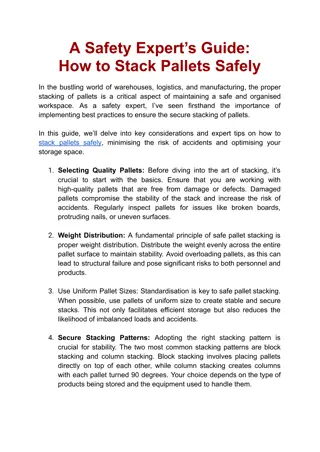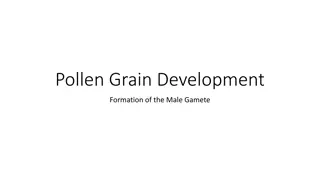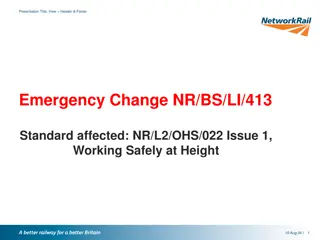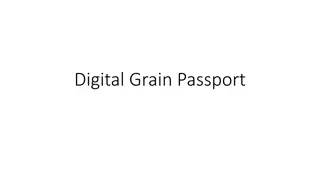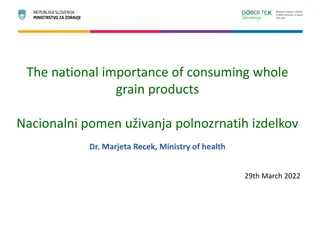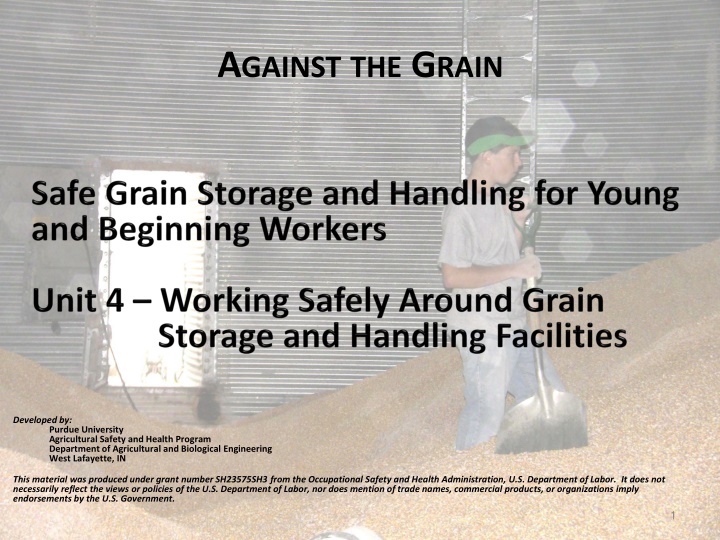
Safe Worker Characteristics and Dress Code in the Grain Industry
Learn about the traits of a safe and productive worker, the risks associated with certain worker characteristics, appropriate work attire, and the importance of workplace safety in the grain industry. Discover how to improve safety measures and promote a secure work environment for all employees.
Download Presentation

Please find below an Image/Link to download the presentation.
The content on the website is provided AS IS for your information and personal use only. It may not be sold, licensed, or shared on other websites without obtaining consent from the author. If you encounter any issues during the download, it is possible that the publisher has removed the file from their server.
You are allowed to download the files provided on this website for personal or commercial use, subject to the condition that they are used lawfully. All files are the property of their respective owners.
The content on the website is provided AS IS for your information and personal use only. It may not be sold, licensed, or shared on other websites without obtaining consent from the author.
E N D
Presentation Transcript
AGAINSTTHE GRAIN Developed by: Purdue University Agricultural Safety and Health Program Department of Agricultural and Biological Engineering West Lafayette, IN This material was produced under grant number SH23575SH3 from the Occupational Safety and Health Administration, U.S. Department of Labor. It does not necessarily reflect the views or policies of the U.S. Department of Labor, nor does mention of trade names, commercial products, or organizations imply endorsements by the U.S. Government. 1
Objectives Describe the characteristics of a safe and productive worker Describe the characteristics of a worker that increases the risk of injury Describe the appropriate dress for a safe worker Identify the types and uses of basic PPE used in the grain industry Explain the rights of workers under the provisions of OSHA 2
Introduction The leading cause of death for those under 26 is traumatic injuries Motor vehicle crashes Drowning's and suffocation Fires and burns Other machines Working in the grain industry exposes youth to all of these hazards and more 3
Who Can Remember Why Young Workers Are More Vulnerable to Injury? Lack of training and experience Lack of knowledge about hazards Don t have the ability to assess risk Natural risk takers Lack coordination and physical strength Lack of maturity Impatient More emotional 4
Characteristics of a Safe Worker Commitment to a safe and productive workplace Knowledge of workplace hazards Patience Civility and courtesy Self control Confidence Consideration towards others PICTURE 5
Worker Characteristics That Increase the Risk of Injury Unmanaged emotions fears, anger, resentment Influenced by drugs or alcohol Fatigue lack of sleep Preoccupation 6
Coming Dressed to Work The right clothes for the job Close fitting, durable clothing No loose strings or hair Temperature appropriate Protection from the sun Sturdy footwear steel toed shoes Personal identification Your appearance is a reflection on your employer Picture of guy ready to work 7
Personal Protective Equipment Head Eyes Hearing Respiratory Skin Feet Fall protection 8
Employers Are Required to Provide Necessary Personal Protective Equipment Employees have a right to the PPE required to perform a job safely Employers are responsible to provide the PPE at no cost to the employee, conduct training on its use and care, and ensure that employees use it 9
Respiratory Protection N95 mask Self-Contained Breathing Apparatus 10
Air Quality Monitoring Equipment Single gas air quality monitors Multi gas air quality monitor 13
Importance of an Up-to-Date Tetanus Vaccination Workers are exposed to sharp objects that can cause puncture wounds which can become infected with tetanus Tetanus germ in soil, dust, & manure Tetanus toxin is one of the most potent poisons Life threatening 15
Smoking Around Grain Storage and Handling Facilities is Not Allowed 16
Worker Rights Workers are entitled to working conditions that do not pose a risk of serious harm. To help ensure a safe and healthful workplace, OSHA also provides workers with other rights including: Using their rights under the law without retaliation and discrimination; Access to information and training about hazards, methods to prevent harm, and the OSHA standards that apply to their workplace. The training must be in a language they can understand; Review records of work-related injuries and illnesses; For more information, visit the Workers page. 17
Complaint Filing Options You have these options to file your safety and health complaint: Online - Go to the Online Complaint Form at www.OSHA.gov Download and Fax/Mail - Download the OSHA compliant form* [En Espanol*] Telephone - your local OSHA Regional or Area Office. OSHA staff can discuss your complaint and respond to any questions you have. If there is an emergency or the hazard is immediately life-threatening, call your local OSHA Regional or Area Office or 1-800-321- OSHA. 18


